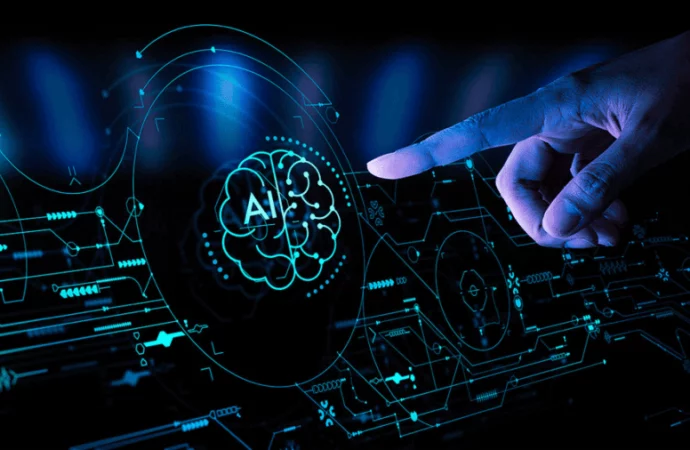In today’s interconnected world, the digital landscape is rife with opportunities and threats. As organizations increasingly rely on digital solutions for their operations, the need for robust cybersecurity measures has never been more critical. Artificial Intelligence (AI) has emerged as a powerful ally in the fight against cyber threats, enhancing the capabilities of cybersecurity systems
AI in cybersecurity refers to the use of machine learning, algorithms, and data analytics to identify, prevent, and respond to cyber threats. By processing vast amounts of data at unprecedented speeds, AI can uncover patterns and anomalies that traditional security measures might miss, making it an indispensable tool for modern security infrastructures.
Enhanced Threat Detection and Response

Image by Yandex.com
One of the most significant advantages of AI in cybersecurity is its ability to detect threats more accurately and swiftly than human analysts. AI systems can analyze historical data to learn what normal behavior looks like within an organization, enabling them to identify deviations that may indicate potential security breaches. For example, if an employee who typically accesses data during business hours suddenly begins logging in at odd times or downloading large amounts of data, AI can flag this activity as suspicious.
Automation of Repetitive Tasks
AI can automate routine cybersecurity tasks, freeing up human analysts to focus on more complex issues. Tasks such as monitoring network traffic, updating security protocols, and responding to low-level threats can be handled by AI systems. This not only improves efficiency but also reduces the risk of human error, which can lead to significant security vulnerabilities.
Improved Accuracy in Identifying Threats
Machine learning algorithms can continuously improve their accuracy as they process more data. This means that AI-driven cybersecurity tools become better at distinguishing between legitimate and malicious activities over time. By reducing false positives, organizations can allocate resources more effectively, focusing on genuine threats rather than wasting time investigating benign activities.
Real-Time Monitoring and Analysis

Image by Yandex.com
AI enables organizations to monitor their systems in real time, providing instant alerts when suspicious activities are detected. This capability is crucial in today’s fast-paced digital environment, where cyberattacks can occur within seconds. By having real-time insights, organizations can respond to threats promptly, minimizing potential damage.
Real-World Examples of AI in Cybersecurity
-
AI-Powered Tools for Threat Detection
Various AI-powered tools have emerged to help organizations combat cyber threats. For instance, Darktrace employs AI algorithms to create a “self-learning” security system that can identify and respond to anomalies in real time. The system uses unsupervised machine learning to understand normal network behavior and can autonomously respond to threats, providing organizations with an additional layer of defense.
-
Case Study: Google’s AI Cyber Defense Initiative
Google has taken significant steps to integrate AI into its cybersecurity framework. The Google AI Cyber Defense Initiative leverages machine learning to enhance the company’s security infrastructure. By analyzing vast amounts of data from user interactions and potential threats, Google’s AI can quickly identify vulnerabilities and implement protective measures. This proactive approach not only safeguards Google’s systems but also helps protect its users’ data from potential breaches.
-
Case Study: IBM’s AI Security Solutions
IBM has developed a range of AI-powered cybersecurity solutions designed to help organizations detect, respond to, and mitigate cyber threats. One notable example is IBM Security QRadar, which utilizes AI to analyze security data and identify potential risks. The platform can correlate data from various sources, providing security teams with a comprehensive view of their security landscape. Additionally, IBM’s Watson for Cyber Security harnesses the power of AI to analyze unstructured data, enabling security analysts to focus on critical threats rather than sifting through vast amounts of information.
Challenges in Implementing AI in Cybersecurity
While the benefits of AI in cybersecurity are significant, organizations must also navigate several challenges when implementing these technologies.
-
Data Privacy Concerns
The use of AI in cybersecurity often involves processing vast amounts of sensitive data, raising concerns about data privacy and compliance with regulations such as GDPR. Organizations must ensure that their AI systems are designed to protect user data and adhere to legal requirements.
-
Potential for AI to Be Weaponized
As AI technology becomes more advanced, there is a growing risk that malicious actors could use AI for cyberattacks. For example, AI could be employed to automate phishing attacks or to develop sophisticated malware that can adapt to existing security measures. This dual-use nature of AI poses a significant challenge for cybersecurity professionals.
-
Need for Skilled Personnel
Implementing AI in cybersecurity requires skilled personnel who understand both AI technology and cybersecurity principles. There is currently a shortage of professionals with expertise in both fields, making it challenging for organizations to effectively leverage AI in their security efforts.
Future of AI in Cybersecurity
The future of AI in cybersecurity looks promising, with several trends likely to shape its evolution.
-
Trends in AI Technology and Cybersecurity
As AI technology continues to advance, we can expect to see more sophisticated algorithms capable of detecting and responding to threats in real time. Additionally, the integration of AI with other emerging technologies, such as blockchain and Internet of Things (IoT), will create new opportunities for enhancing cybersecurity measures.
-
Importance of Collaboration Between AI and Human Analysts
While AI can significantly enhance cybersecurity, it is essential to recognize the value of human intuition and expertise. Cybersecurity professionals will continue to play a crucial role in interpreting AI-generated insights, making informed decisions, and addressing complex threats. The collaboration between AI systems and human analysts will be key to building resilient cybersecurity frameworks.
Conclusion
AI is transforming the cybersecurity landscape by providing organizations with advanced tools to detect and respond to threats. The benefits of AI, including enhanced threat detection, automation of tasks, improved accuracy, and real-time monitoring, make it an invaluable asset for modern security infrastructures. However, organizations must also navigate challenges such as data privacy concerns, the potential for AI to be weaponized, and the need for skilled personnel.
As we look to the future, the continued integration of AI in cybersecurity will be essential for protecting digital assets in an increasingly complex threat landscape. By balancing innovation with risk management, organizations can leverage AI to create robust security measures that safeguard their operations and protect their users.
FAQs
What is the role of AI in cybersecurity?
AI plays a crucial role in cybersecurity by enhancing threat detection, automating routine tasks, and providing real-time analysis of potential security incidents. It uses machine learning algorithms to analyze vast amounts of data, identify patterns, and detect anomalies that may indicate cyber threats.
How does AI improve threat detection?
AI improves threat detection by learning from historical data to establish a baseline of normal behavior within an organization. This allows AI systems to quickly identify deviations from this baseline that may signify a security breach. Additionally, AI can analyze multiple data sources simultaneously, making it more effective at spotting complex threats than traditional methods.
What are the challenges of implementing AI in cybersecurity?
Some challenges of implementing AI in cybersecurity include data privacy concerns, the potential for AI to be misused by cybercriminals, and the need for skilled personnel who understand both AI technology and cybersecurity. Organizations must also ensure their AI systems comply with relevant regulations and protect sensitive information.
Can AI be used against cybersecurity measures?
Yes, while AI can enhance cybersecurity, it can also be weaponized by malicious actors. Cybercriminals may use AI to automate attacks, develop sophisticated malware, or create realistic phishing schemes that are harder for traditional security measures to detect. This dual-use nature of AI poses significant challenges for cybersecurity professionals.
How should organizations prepare for the future of AI in cybersecurity?
Organizations should invest in training their cybersecurity personnel to understand AI technologies and how to leverage them effectively. They should also adopt a collaborative approach, integrating AI tools with human expertise. Additionally, staying informed about emerging AI trends and potential threats will help organizations adapt their cybersecurity strategies to a rapidly evolving landscape.






















